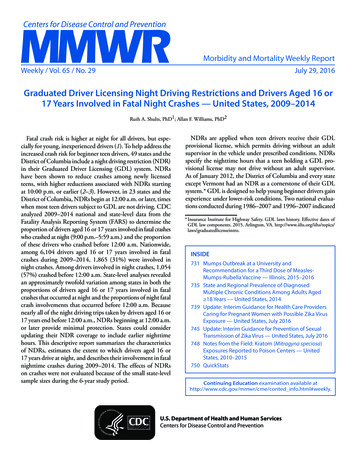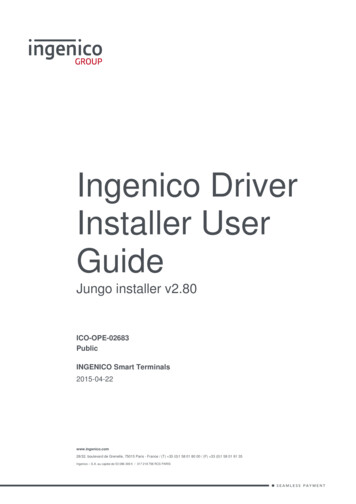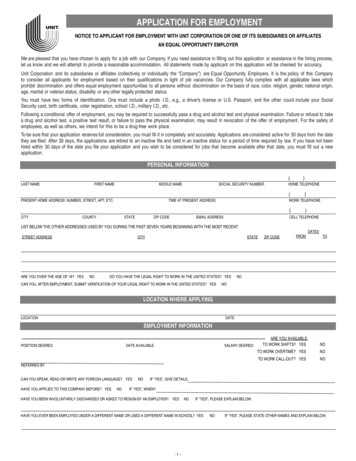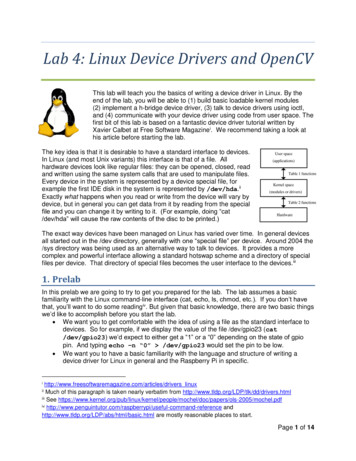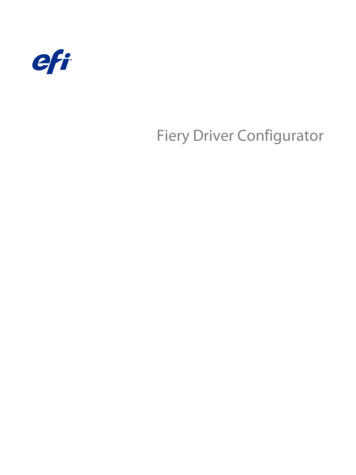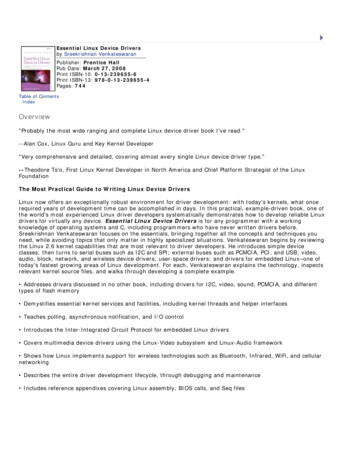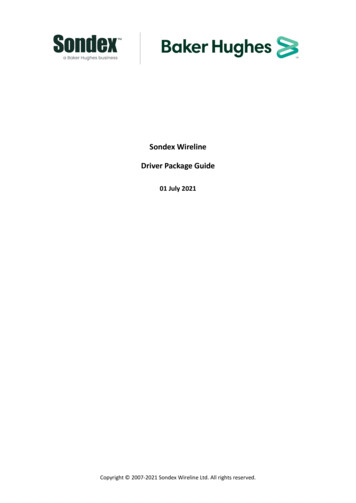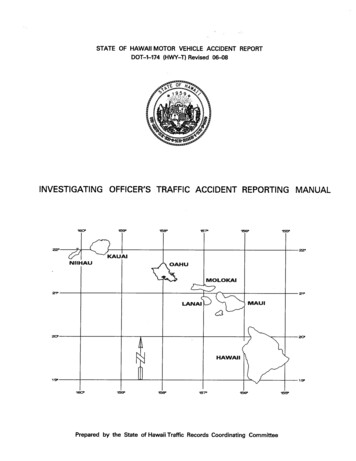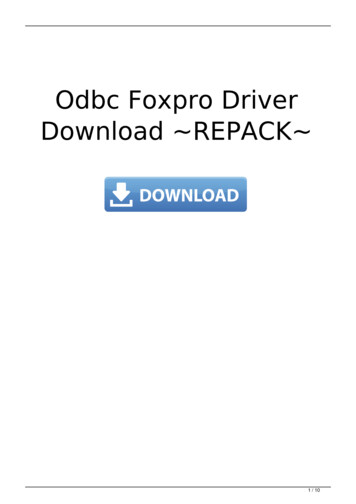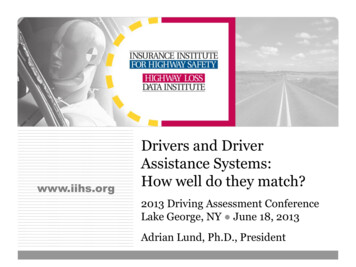
Transcription
www.iihs.orgDrivers and DriverAssistance Systems:How well do they match?2013 Driving Assessment ConferenceLake George, NY June 18, 2013Adrian Lund, Ph.D., President
The Insurance Institute for Highway Safety,founded in 1959, is an independent, nonprofit, scientific, and educationalorganization dedicated to reducing the losses — deaths, injuries, andproperty damage — from crashes on the nation’s roads.The Highway Loss Data Institute,founded in 1972, shares and supports this mission through scientificstudies of insurance data representing the human and economic lossesresulting from the ownership and operation of different types of vehiclesand by publishing insurance loss results by vehicle make and model.Both organizations are wholly supported by auto insurers.www.iihs.org
Where are we?Location of IIHS/HLDI and Vehicle Research CenterWashington, .org
IIHS members write 85% of private passenger market ACE Private Risk Services Farmers Mutual of Nebraska Nodak Mutual Insurance Company Affirmative Insurance Fireman's Fund Insurance Company Norfolk & Dedham Group Agency Insurance Company of Maryland First Acceptance Corporation North Carolina Farm Bureau Mutual Insurance Company Alfa Alliance Insurance Corporation Florida Farm Bureau Insurance Companies Northern Neck Insurance Company Alfa Insurance Frankenmuth Insurance Old American County Mutual Fire Insurance Allstate Insurance Group Gainsco Insurance Oregon Mutual Insurance American Family Mutual Insurance GEICO Group Pekin Insurance American National Property and Casualty Company Georgia Farm Bureau Mutual Insurance Company PEMCO Insurance Ameriprise Auto & Home GMAC Personal Lines Insurance Plymouth Rock Assurance Amica Mutual Insurance Company Grange Insurance Progressive Corporation ARI Insurance Companies Hallmark Insurance Company The Responsive Auto Insurance Company Auto Club Enterprises Hanover Insurance Group Rockingham Group Auto Club Group The Hartford Safeco Insurance Bankers Insurance Group Haulers Insurance Company Inc. Samsung Fire & Marine Insurance Company Bituminous Insurance Companies Homeowners of America Insurance Company SECURA Insurance California Casualty Group Horace Mann Insurance Companies Sentry Insurance California State Auto Group ICW Group Shelter Insurance Capital Insurance Group Imperial Fire & Casualty Insurance Company Sompo Japan Insurance Company of America Chubb & Son Infinity Property & Casualty South Carolina Farm Bureau Mutual Insurance Company Colorado Farm Bureau Mutual Insurance Company Kemper Preferred Southern Farm Bureau Casualty Insurance Company Concord Group Insurance Companies Kentucky Farm Bureau Insurance State Auto Insurance Companies Cotton States Insurance Liberty Mutual Insurance Company State Farm COUNTRY Financial Louisiana Farm Bureau Mutual Insurance Company Tennessee Farmers Mutual Insurance Company Direct General Corporation Maryland Automobile Insurance Fund Texas Farm Bureau Insurance Companies Discovery Insurance Company Mercury Insurance Group Tower Group Companies Driver’s Insurance Group MetLife Auto & Home The Travelers Companies Erie Insurance Group MiddleOak United Educators Esurance Mississippi Farm Bureau Casualty Insurance Company USAA Farm Bureau Financial Services MMG Insurance Viceroy Insurance Company Farm Bureau Insurance of Michigan Mutual of Enumclaw Insurance Company Virginia Farm Bureau Mutual Insurance Farm Bureau Mutual Insurance Company of Idaho Nationwide West Bend Mutual Insurance Company Farmers Insurance Group of Companies New Jersey Manufacturers Insurance Company Young America Insurance Company Farmers Mutual Hail Insurance Company of Iowa NLC Insurance Companies Inc. Zurich North Americawww.iihs.org
Institute activitiesWe do not lobby, legislate, or litigate Priority 1 – objective research on policy options to reduce injuriesand property damage from motor vehicle crashes Priority 2 – effective communications to make researchinformation attractive to news media– News releases (TV, print, Internet)– Films– Testimony at state and federal legislative and regulatory hearings– Briefings of other stakeholders, including vehicle manufacturers IIHS and HLDI rely on aggressive research and communicationsto empower people and policymakers with objective informationwww.iihs.org
IIHS research and communications cover a widearray of highway safety issueswww.iihs.org
50th Anniversary crash test1959 Bel Air vs. 2009 Malibuwww.iihs.org
Overview of presentation Some surprising findings about driver behavior and crashes– Infotainment technology– Advanced driver assistance systems (collision warnings, headlamps,cameras) Questions raised about how drivers drive– To what extent do drivers consciously control their actions?– What is attention? Reducing crash risk– Advanced technology– Old technologywww.iihs.org
Fatalities and fatal crash risk per mile traveled havedeclined steadily since peaking in the 1960s60,00080crash deaths per billion vehicle miles traveled55,00060motor vehicle crash deaths50,00045,0004040,00011 per 20000510www.iihs.org
Role of driver error has not changed 1979 Indiana “Tri-Level Study” estimated driver error as proximatecause of 9 out of 10 crashes 2008 National Motor Vehicle Crash Causation Study cited driver erroras the critical reason for the crash in 95% of crashes where reasonwas assignedCritical reason attributed to driver (top 5):Inadequate surveillance (19%)Internal distraction (10%)Too fast for conditions (8%)Too fast for curve (5%)Overcompensation (5%)www.iihs.org
In-vehicle technologies:New distractions or driver aids?www.iihs.org
Infotainment features Cellphones iPods Navigation systems– Mobile– Built-in Radios becoming more complex– Multiple bands– Built-in controls for iPods– CD/DVD players– Music streamingwww.iihs.org
Advanced information technology for safetylane departure preventioncrash notificationblind spot detectionservercellphoneforward collision warningand auto brakingadaptive headlightsvehicle-to-vehicle communicationwww.iihs.org
Infotainment usage by driversincreased greatly in the early2000sWhat is the effect on crashes?The case of cellphoneswww.iihs.org
Cellphone subscribersIn millions, iihs.org
Percent of drivers talking on phonesNational observational surveys, NHTSA, 2000-111210864estimated total phone use2observed hand-held phone hs.org
Cellphones and crash risk Multiple laboratory studies demonstrate thatcellphone dialing and talking are distracting(i.e., reduce performance on simultaneous task) Case-crossover epidemiologic studies in Canadaand Australia indicate four-fold crash risk whendrivers are talking on their phones Virginia Tech naturalistic driving study (2013)suggests a smaller increase in crash risk– 1.39 times the risk of a safety critical event duringhand-held phone useNo increased risk while talking– 1.73 times the risk of safety critical event during textmessaging or browsing on cellphonewww.iihs.org
All police-reported crashes per billion miles traveledBy calendar org
Summary thoughts on infotainment and crashes Infotainment usage distracts– In some cases greatly– Even voice-activated systems Crashes have occurred because drivers were distracted bycellphones and other devices No dose response relationship between population cellphoneuse (and other electronics) and crashesThis poses a scientific conundrum:Specifically, how can highly distracting activities that are increasingin frequency in the population not be associated with an increase incrashes for the population?Is there a psychological issue here – another factor needed in ourintuitive model of driver attention?www.iihs.org
How are advanced driverassistance systems working?Forward collision warning,with and without automaticbraking, is working as expectedwww.iihs.org
Volvo XC60 with City Safety (low speed autobrake)vs. other 2009-12 midsize luxury SUVsProperty damage liability claims per 100 vehicle years, 2009-121086420www.iihs.org
High speed forward collision warning, with andwithout autonomous brakingProperty damage liability claim frequency by manufacturer20%10%0%-10%-20%Acura withauto brakeMercedes withauto brakeVolvo withauto brake(& LDW)Mercedes withoutauto brakeVolvo withoutauto brakewww.iihs.org
Adaptive headlights (steeringresponsive lamps) are working butnot on single vehicle run-off-roadcrashes as expectedAdaptive headlights seem not to bereducing insurance collision claims,the kind of claim that would resultfrom a single-vehicle crash (possibleexception of Mazda)www.iihs.org
Adaptive headlightsPercent change in collision claims per insured vehicle org
However, vehicles with adaptiveheadlights are involved in fewercrashes with other vehicles forwhich that vehicle is responsible,as indicated by a reduction inproperty damage liability claimsand in claims for injuries inother vehicleswww.iihs.org
Adaptive headlightsPercent change in property damage liability claims per insuredvehicle s.org
Adaptive headlightsPercent change in bodily injury claims per insured vehicle s.org
Some crash avoidance systemsare showing no effectivenessLane departure warning(LDW, without active lanekeep assistance) may be increasingcrashes claimed with insurerswww.iihs.org
LDW is not reducing crash incidencePercent change in vehicle damage claims per insured vehicle -10Buick (w/ Blindspot)MercedesVolvo (w/ FCW/AEB)www.iihs.org
Only Volvo LDW systems areassociated with decreases inclaim frequency, and that islikely due to the forward collisionwarning with autonomousbraking system, which always ispaired with LDWwww.iihs.org
LDW is not reducing injury incidencePercent change in claims per insured vehicle year0-10Bodily PayMedPay and PIP(1st party injuries)PIP400Buick (w/ Blindspot)MercedesVolvo (w/ FCW/AEB)www.iihs.org
Percent of owners who drive with lane departurewarning turned on100806040didn’t know itwas on vehiclenever20sometimesalways0Volvo lane departure warning(2009)Volvo lane departure warning(2012)Infiniti lane departure warning(2009)(n 86)(n 299)(n 301)www.iihs.org
Questions raised about howdrivers drive:How much of driving isconsciously controlled?www.iihs.org
Intuitive model of driver behaviorOversimplified but useful for this discussion Drivers set out to get from point A to point B without crashing– With rare exceptions of suicide and homicide Drivers (safe ones) constantly scan the road ahead and behindfor risk– Drivers are cognitively engaged with the task unless attention isdiverted to unrelated activity (distraction) Infotainment devices bring additional cues for behaviorunrelated to the task of driving– These cues increase distraction from primary vehicle control task Crash avoidance features cue drivers when their distractionshave led to danger– These cues return drivers’ attention to primary vehicle control taskwww.iihs.org
Is cognitive engagement the default driver state?Mind wandering is common “We developed a smartphone technology to sample people’s ongoingthoughts, feelings, and actions and found (i) that people are thinkingabout what is not happening almost as often as they are thinking aboutwhat is and (ii) found that doing so typically makes them unhappy.”– Killingsworth, M.A. and Gilbert, D.T. 2010. A wandering mind is an unhappymind. Science, 330, 932. “ people adjust their effort to the immediate and prospective demandsof tasks that are put before them.”– Hancock, P.A. 2013. In search of vigilance: The problem of iatrogenicallycreated psychological phenomena. American Psychologist, 68(2), 97-109.www.iihs.org
How great are the situational demands for cognitivecontrol of driving ? Driving for most of us is an overlearned behavior Overlearned behaviors may have limited conscious control;for example– Throwing a baseball does not involve calculation of parabolictrajectories but rather the exercise of brain-muscle connectionsdeveloped with practice– Maintaining lane position and driving around curves is easier if onelooks ahead to where the vehicle is going rather than nearby, tryingto control distance to road edge lines precisely Sometimes we arrive at our destinations with little memory ofhow we got there– Do you remember your drive to the airport to come here?www.iihs.org
What does it mean to pay attention to driving? Conscious attention to paying attention is not attention to thedriving task– That’s like being proud of humility If most driving is habitual, then driving effectiveness depends on– The adequacy of overlearned driving habits (hence the importance ofgraduated licensing)– The degree to which the road environment engages the driver’sattention when necessary (road geometry and rules of the road)– Recapturing attention when unusual circumstances arise (specialsigning – flashing lights, crash avoidance features)www.iihs.org
Implications for advanced driver assistance systems Forward collision prevention– Systems appear to work– Cues are effectiveBut not always, because autonomous braking improves effectiveness– One surprising finding is equivalence of different alert strategies asindicated in equivalent findings across automakers Adaptive (steering responsive) headlamps– Benefits consistent with the addition of information that fits drivers’habits– Although data are preliminary, other lighting improvements also seemto reduce insurance crash claimswww.iihs.org
Implications for advanced driver assistance systems Lane departure warning– Cues are ineffective– If the negative effect is real, is it possible that exposure to nonmeaningful warnings may be making drivers less sensitive to all cues? Implication for V2V and V2I communications– These can greatly increase information coming to drivers– What problems may occur if too much of the information has limitedimplications for immediate behavior?Providing these cues hypothesizes that what the car thinks drivers should focus on ismore important than what the driver is focused onIs information that has no immediate behavioral value distracting from the driving task?www.iihs.org
Improvements in driverattention and performance maynot require new technologyRed light cameras alreadyare making drivers pay moreattention at intersectionswww.iihs.org
In 2011 on US roads,about 150,000 red-lightrunning crashes causedabout 118,000 injuriesand about 700 deaths.www.iihs.org
Percent difference in actual fatal crash rates during2004-08 in 14 large cities with red light cameras vs.expected rates without cameras0-10-20-30red light runningfatal crashesfatal crashesat intersectionswith signal lightswww.iihs.org
Red light cameras aresometimes criticized forenforcing right-turn-on redrules. However, stop-beforeturning rules are meant toprotect pedestrians from driverswho might otherwise be lookingleft for oncoming traffic whenpedestrians enter the road fromthe right.www.iihs.org
www.iihs.org
Roundabouts also reduce crashesIs that partly because they makedrivers pay attention (as well asslow down)?www.iihs.org
Roundabouts are safer and more efficientwww.iihs.org
Roundabouts require drivers to:slow down,look for traffic in the circle,negotiate the circle,watch for other traffic enteringthe circle.www.iihs.org
Estimated crash reductions if 10 percent of signalizedintersections in US converted to roundabouts Approximately 43,000 crashes prevented in 2011 including:– 170 fatal crashes– 28,000 injury crasheswww.iihs.org
Estimated annual economic savings if 10 percent ofsignalized intersections in US converted to roundabouts Vehicle delays reduced by more than 900 million hours Fuel consumption reduced by more than 600 million gallonswww.iihs.org
Conclusion Infotainment and crash avoidance features promise toproliferate in the near term Our intuitive model of driver behavior – that the default driverstate is cognitive attention to the task – probably misleads us– Effective integration of these features into the driving environmentrequires recognition thatMuch of our daily lives involves mind wanderingMuch of driving behavior is habitual, with limited cognitive control Key question for all of us: How do we get drivers theinformation they need and want without distracting them fromthe driving task as they perform it?www.iihs.org
PostscriptResearch planned atthe Insurance Institutefor Highway Safetywww.iihs.org
vehicle to pedestrianvehicle to stationary vehiclevehicle to moving vehiclewww.iihs.org
Planned expansion of test track capabilitywww.iihs.org
Covered test trackSteel and tensile fabric structurewww.iihs.org
Form to finish first of 18 support pierswww.iihs.org
www.iihs.orgDedicated to reducing deaths, injuries,and property damage on the highway
The Responsive Auto Insurance Company Rockingham Group Safeco Insurance Samsung Fire & Marine Insurance Company SECURA Insurance Sentry Insurance Shelter Insurance Sompo Japan Insurance Company of America South Carolina Farm Bureau Mutual Insurance Company
